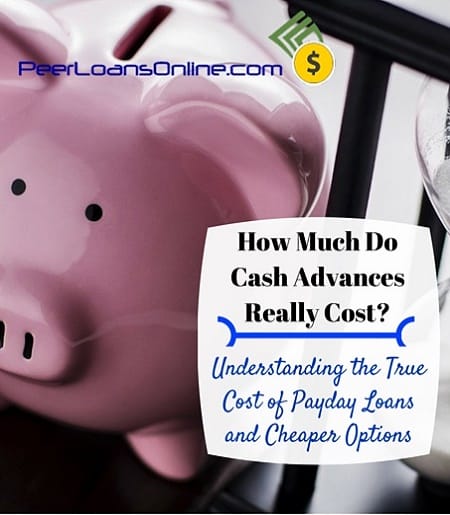Understand the real cost of cash advance and payday loans to find better options
I posted a review of some of the best payday loan sites for bad credit a few weeks ago with the disclaimer that these quick loans are rarely the best option. I wanted to go back to the idea because I don’t think a lot of people understand the true cost of a cash advance. The loan fee charged on payday loans may seem small but it can be up to 20 times the cost of other types of loans.
Like I said in the review of payday loan sites, I realize that you may not always have a choice. If you need cash in less than a day to avoid paying a late fee then you may need that cash advance. You may be surprised though how easy it is to get a personal loan, especially from one of the bad credit lenders like Avant
Let’s look at how cash advance and payday lenders can charge such high rates first before looking at the real cost of cash advances.
How Can Cash Advance and Payday Loans Charge so Much?
Every state has what’s called Usury laws. The word ‘usury’ is as old as the bible and just means excessive interest on a loan. Usury laws protect borrowers by limiting the amount of interest that can be charged on a loan, basically keeping people from becoming slaves to their creditors.
Most states prohibit interest rates above 35% or so on personal loans. Cash advance and payday lenders get around this by charging a “fee” and by calling the money something other than a ‘loan.’ Since it’s not interest on a loan then it doesn’t fall under the usury laws and lenders can pretty much charge whatever they want.
The average fee for every $100 cash advance is between $10 to $30 and is due within 14 to 30 days. Some states do have payday lending laws but the fees are still very high. For example, Oregon borrowers can borrow a maximum of $300 every month for a $39.10 fee. That still amounts to an annual interest rate of 153% but isn’t even close to what their neighbors pay.
California borrowers can borrow up to $255 every two weeks for a $45 fee, amounting to a rate of 460% on an annual basis.
What’s the True Cost of a Cash Advance or Payday Loan?
Where the cash advance and payday loans get you is the constant renewals or rollovers. You may be able to pay back the loan when your check gets deposited but what about the next two weeks? You’ve already spent a good chunk of your paycheck and need to worry about putting food on the table. Cash advance stores might as well put in revolving doors.
Check out the graph on the real cost of a payday loan. The graph shows the cost of a $300 cash advance for a fee of $20 over two weeks. That first loan fee is only 6.7% of the advance, not too bad, but if you take out just three advances per year…you’re paying a 20% interest rate.
If this were a normal loan or you had to refinance your cash advance every two weeks, you would end up paying $520 in fees just on a $300 loan. That is an annual interest rate of 173%, and the fees on this loan are actually pretty small.
The problem is that a cash advance really isn’t a solution. It doesn’t help your credit score and it only adds another bill you’ve got to pay every couple of weeks. If you’re only relying on cash advances or payday loans, you’ll always be stuck in the same cycle and paying 100%+ interest rates.
Understanding the true cost of a cash advance is only helpful if you use the information to avoid falling into the payday loan trap. Instead of a cash advance, consider one of these personal loan sites with rates as low as 6% and terms from two to five years. You’ll be able to borrow enough that you can stop constantly having to go to the payday lender and will save hundreds in interest charges. The loan will help you build your credit score until you are able to get much lower rates.
